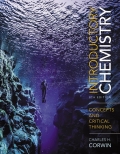
(a)
Interpretation:
The formula unit formed by the combination of cation
Concept introduction:
Formula unit is the empirical formula of the ionic and covalent compound which is used in stoichiometric calculations. Formula unit for the ionic compound is the ratio of the lowest whole number. In ionic compounds, the charge of the cation is written as a subscript of the anion. On the other hand, the charge on anion is written as a subscript on the cation.
Answer to Problem 82E
The formula unit formed by the combination of cation
Explanation of Solution
The cation
The formula unit for cation
(b)
Interpretation:
The formula unit formed by the combination of cation
Concept introduction:
Formula unit is the empirical formula of the ionic and covalent compound which is used in stoichiometric calculations. Formula unit for the ionic compound is the ratio of the lowest whole number. In ionic compounds, the charge of the cation is written as a subscript of the anion. On the other hand, the charge on anion is written as a subscript on the cation
Answer to Problem 82E
The formula unit formed by the combination of cation
Explanation of Solution
The cation
The formula unit for cation
(c)
Interpretation:
The formula unit formed by the combination of cation
Concept introduction:
Formula unit is the empirical formula of the ionic and covalent compound which is used in stoichiometric calculations. Formula unit for the ionic compound is the ratio of the lowest whole number. In ionic compounds, the charge of the cation is written as a subscript of the anion. On the other hand, the charge on anion is written as a subscript on the cation
Answer to Problem 82E
The formula unit formed by the combination of cation
Explanation of Solution
The cation
The formula unit for cation
(d)
Interpretation:
The formula unit formed by combination of cation
Concept introduction:
Formula unit is the empirical formula of the ionic and covalent compound which is used in stoichiometric calculations. Formula unit for the ionic compound is the ratio of the lowest whole number. In ionic compounds, the charge of the cation is written as a subscript of the anion. On the other hand, the charge on anion is written as a subscript on the cation
Answer to Problem 82E
The formula unit formed by combination of cation
Explanation of Solution
The cation
The formula unit for cation
Want to see more full solutions like this?
Chapter 12 Solutions
EBK INTRODUCTORY CHEMISTRY
- b. ὋΗ CH3CH2OH H2SO4arrow_forwardFor the reaction A (g) → 3 B (g), Kp = 0.379 at 298 K. What is the value of ∆G for this reaction at 298 K when the partial pressures of A and B are 5.70 atm and 0.250 atm?arrow_forward14. Calculate the concentrations of Ag+, Ag(S2O3), and Ag(S2O3)23- in a solution prepared by mixing 150.0 mL of 1.00×10-3 M AgNO3 with 200.0 mL of 5.00 M Na2S2O3 Ag+ + S20 Ag(S203)¯ K₁ = 7.4 × 108 Ag(S203)¯ + S20¯ = Ag(S203) K₂ = 3.9 x 104arrow_forward
- ΗΝ, cyclohexanone pH 4-5 Draw Enamine I I CH3CH2Br THF, reflux H3O+ I Drawing Draw Iminium Ionarrow_forward:0: :0: Select to Add Arrows :0: (CH3)2NH :0: ■ Select to Add Arrows :0: :0: (CH3)2NH ■ Select to Add Arrowsarrow_forwardDraw the product of the following H action sequence. Ignore any inorganic byproducts formed. 1. (CH3CH2)2CuLi, THF 2. CH3Br Q Atoms, Bonds and Rings H Charges ㅁarrow_forward
- Please help me with this the problem is so confusingarrow_forward14 Question (1 point) Disiamylborane adds to a triple bond to give an alkenylborane. Upon oxidation with OH, H2O2, the alkenylborane will form an enol that tautomerizes to an aldehyde. In the first box below, draw the mechanism arrows for the reaction of disiamylborane with the alkyne, and in the last box draw the structure of the aldehyde. 4th attempt Feedback i > 3rd attempt OH, H2O2 i See Periodic Table See Hintarrow_forwardanswer with mechanisms and steps. handwritten please!arrow_forward
- Hello I need some help with Smartwork. For drawing structure B, I know the correct answer is CH₃B₂, but when I try to type it in, it keeps giving me CH₄BH₃ instead. Do you know how I should write it properly? Should I use a bond or something else?arrow_forwardTrue or false, chemistryarrow_forwardanswer thse questions with mechanisms and steps. handwritten please!arrow_forward
 Introduction to General, Organic and BiochemistryChemistryISBN:9781285869759Author:Frederick A. Bettelheim, William H. Brown, Mary K. Campbell, Shawn O. Farrell, Omar TorresPublisher:Cengage Learning
Introduction to General, Organic and BiochemistryChemistryISBN:9781285869759Author:Frederick A. Bettelheim, William H. Brown, Mary K. Campbell, Shawn O. Farrell, Omar TorresPublisher:Cengage Learning General, Organic, and Biological ChemistryChemistryISBN:9781285853918Author:H. Stephen StokerPublisher:Cengage Learning
General, Organic, and Biological ChemistryChemistryISBN:9781285853918Author:H. Stephen StokerPublisher:Cengage Learning

